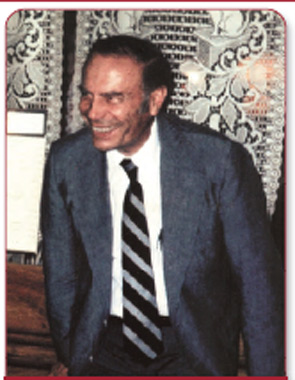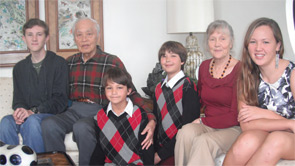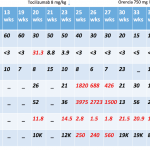In the mid-1960s, a young physician at Rockefeller University in New York City was caring for a young girl with the debilitating autoimmune disorder systemic lupus erythematosus (SLE), as had other rheumatology colleagues before him. As a research fellow, he was also putting in long hours performing experiments using her sera to detect precipitating antibodies against cellular and tissue antigens. Using the Ouchterlony agar diffusion method, he and his mentor, Henry Kunkel, MD, observed that a certain number of SLE sera produced precipitin bands with soluble tissue extracts that could not be explained on the basis of their DNA or nucleoprotein content.1
The physician, Eng M. Tan, MD, had landed on a discovery that would revolutionize the diagnosis of lupus. Further investigations using the antibodies to the Sm antigen (named in honor of the patient, Stephanie Smith) would yield not only new diagnostic markers for lupus but also novel research directions and ideas for the field of molecular biology. And that was just the start of an illustrious and productive career.
“Dr. Tan has contributed more than anybody else in the world to the study and diagnostic usefulness of antibodies to nuclear antigens in the rheumatic diseases,” says Mart Mannik, MD, who crossed paths with Dr. Tan in Dr. Kunkel’s laboratory in 1962. Dr. Tan’s discovery of the specificity of these antinuclear antibodies in SLE, scleroderma, and drug-induced lupus opened up a huge field that has benefitted from his discoveries, said Dr. Mannik, who is now professor emeritus in the division of rheumatology at the University of Washington in Seattle, where he steered the division for 34 years.
George C. Tsokos, MD, chief of rheumatology at Beth Israel Deaconess Medical Center in Boston, published a tribute to the 1966 paper in the Journal of Immunology.2 “If Eng Tan didn’t exist, the field [of immunology] would have stayed behind,” he says.
Edward K.L. Chan, PhD, professor of oral biology, anatomy, and cell biology, and UF Research Foundation Professor at the University of Florida Health Science Center in Gainesville, puts it this way: “I think it is fair to say that Eng Tan has stimulated research by showing how autoantibodies can be important tools in molecular and cell biology to understand cellular functions. Many basic scientists have benefitted directly and indirectly from his work.”
Throughout his career, Dr. Tan has also contributed to the world of science, nurturing young investigators; advancing basic science and advocating for its translational applications; and serving his professional scientific organizations with a measured and logical intelligence.
Research a Constant Interest

It was his grandmother, says Dr. Tan, who initially steered him in the direction of medicine. She was a nurse midwife who trained at a U.S. Missionary Hospital in China and later emigrated to Malaysia, where she maintained a successful practice, delivering three generations of babies. “From the time I was very young,” Dr. Tan recalls, “she suggested that I become a doctor. And you know, when you are young, you are very susceptible to suggestions from your elders!”
Dr. Tan was awarded a scholarship to Johns Hopkins University in Baltimore in 1950, where he obtained a bachelor’s degree in chemistry in 1952. Then it was on to medical school, also at Johns Hopkins. “I was very interested in research from early on,” notes Dr. Tan. For example, during the summer following his first year in medical school, Dr. Tan stayed at the campus for a few weeks to do experiments in dog physiology.
During an internship at the Duke University Medical Center in Durham, N.C., from 1956–1957, Dr. Tan participated in literature reviews hosted by Professor Eugene Stead, MD. “I presented papers by a well-known doctor who did work on streptococcal infections and the complications of acute rheumatic fever and glomerulonephritis. That really fascinated me,” he recalls. The author of those papers was Charles Rammelkamp, MD, who taught at Case Western Reserve University in Cleveland. Dr. Tan decided to do his residency at Case Western and, after two years as assistant resident and one year as chief resident, he stayed on for another two years as a research fellow in Melvin Kaplan’s lab, working on streptococcal glomerulonephritis.
It was Dr. Rammelkamp who suggested that Dr. Tan work with Henry Kunkel. “The two people who were the foundations of my research career were Drs. Rammelkamp and Kunkel,” Dr. Tan says. “Henry Kunkel was one of the founding fathers of clinical immunology in the world,” he says. “He was a clinical scientist in the highest sense of the word and mentored many leaders in the ACR.”
After his time at Rockefeller University, Dr. Tan spent two years at the University of Washington in St. Louis as an assistant professor. He then moved to the Scripps Research Institute in La Jolla, Calif., where he became the head of the division of allergy and immunology and, later, head of the division of rheumatology.
Discoveries Mount
“The labs at Scripps were outstanding,” notes Dr. Tan, “but, after 10 years there, I found that I needed access to more clinical specimens for my autoantibody studies.” He moved to the University of Colorado Health Sciences Center in Denver as professor of medicine and head of the division of rheumatic diseases. Collaboration with Gerald P. Rodnan, MD, from the University of Pittsburgh, produced another groundbreaking paper, this time in scleroderma. Drs. Tan and Rodnan demonstrated the diversity of antinuclear antibodies present in the sera of patients with progressive systemic sclerosis, and found that the anticentromere antibody appeared to be highly selective for the CREST variant of PSS, and anti-Scl70 (also known as DNA topoisomerase I) to be highly diagnostic of the systemic form of scleroderma.3
Time as a Mentor
Returning to Scripps after five years in Colorado, Dr. Tan became professor and head of the W.M. Keck Autoimmune Disease Center, Department of Molecular and Experimental Medicine. He is now professor emeritus and continues to consult and work with former fellows from Scripps, many of whom, like Dr. Chan, Gregory J. Tsay, MD, and Yoshinari Takasaki, MD, in Tokyo, have established their own highly successful research laboratories.
Dr. Chan, who spent 18 years at Scripps, appreciated the depth of Dr. Tan’s knowledge of the literature. “Young people read the literature and believe that experiments have already been done and results already known. But [Dr. Tan] has a better sense of what has been published and how reliable those results may be. He knows there are still many unanswered questions that a young investigator is not aware of.”
Dr. Tsay, founder and director of the Institute of Immunology at Chung Shan Medical University in Taichung, Taiwan, and president of the Taiwan Rheumatology Association, echoes Dr. Chan’s impressions. He first met with his mentor during an International Congress of Immunology (ICU) meeting held in Japan in 1983, and six months later he traveled to Scripps to begin his own postdoctoral studies. He recalls that Dr. Tan “always taught us you have to go deeper in research.”
In his 24 years as head of the disease center, Dr. Tan trained close to 100 fellows who came from all over the world and who worked in many different disciplines, not just rheumatology. “I was always impressed,” says Dr. Mannik, “by how he was able to recruit and train young investigators who had a talent for research—and beyond that, he formed lasting friendships with former trainees, regardless of where they came from.”
Not all of the fellows who studied there become independent investigators, Dr. Chan recalls. “I remember, after four or five years [at Scripps] he told me, ‘You have to try hard, and I think you can make it.’ The way he said, ‘I think you can make it,’ made me think more seriously about what is possible. And when he said it was possible, I was encouraged to try harder.”
Society Involvement
Dr. Tan’s measured demeanor and ability to examine context propelled him into positions of importance within the field as well. In 1980–1981, at the request of Daniel J. McCarty, MD, president of the American Rheumatism Association [ARA; now the ACR], Dr. Tan served as chair of a committee charged with updating and revising the 1971 ARA criteria for classification of SLE. With colleagues James Fries, MD, and Dennis McShane, MD, among others, Dr. Tan met at Stanford, home of the Arthritis, Rheumatism and Aging Medical Information Systems (ARAMIS) database. Working efficiently, the committee published the revised criteria, which included antibodies to the Sm antigen, in 1982.4 The criteria are used to this day.
As it happened, Dr. Tan became president of the ARA at a momentous time in its history. Returning from an ARA Interim Scientific Meeting in Palm Springs in 1984 [during those days, the ARA had two meetings a year—an annual meeting in the summer and the Interim Scientific Meeting in the winter], Dr. Tan received a hand delivery from the president of the Arthritis Foundation (AF), Cliff Clarke. In Clarke’s handwritten letter, AF officers asked the ARA to cease activities related to advocacy because they would jeopardize the AF’s tax-exempt status. “This would have meant that, if the ARA stayed as a section of the AF, practicing rheumatologists would have to separate from research rheumatologists,” explained Dr. Tan. The ARA leadership wanted to keep the two facets of rheumatology together, and a decision was made to separate from the AF.
“I spent a lot of time trying to figure out how we could negotiate with the AF for a separation that would allow the ARA to get along for the first couple of years until we got on our feet,” recalls Dr. Tan. “I thought the person who could do it best was Bill Kelley [who later also became president of the ARA] and asked him to chair a negotiating committee. And we were finally able to get a nearly unanimous approval of the ARA membership at our annual meeting in 1985.” In his closing address as outgoing ARA President in 1985, Dr. Tan outlined a three-pronged agenda for the future of the organization: to preserve research (by nurturing research fellows and young investigators, and supporting basic research with partiality to clinical research); to promote education; and to participate in public advocacy.5 The ARA, which later renamed itself the ACR, owes its ongoing strength and vibrancy to those who steered it through the separation.
Dr. Tan also served overlapping terms as chair of the AF Advisory Committee on Standardization of Antinuclear Antibodies (1981–1988) and with the International Union of Immunological Societies’ Committee for Standardization of Autoantibodies (1984–1998; 1989–2000). The latter affiliation is where Josef S. Smolen, MD, recalls his first lengthy personal connection with Dr. Tan. “You know, you meet people on different occasions, and some are serendipitous,” says Dr. Smolen, chair of the department of medicine 3 at the Medical University of Vienna in Austria. “Obviously, I knew Dr. Tan first from the literature as one of the premier scientists in the field of autoimmunity and, in particular, autoantibodies.”

When Drs. Tan, Smolen, Jochen Kalden, Ravinder Maini, and others met at the IUIS meeting in Budapest in the late 1980s, they began in earnest to collaborate through the Subcommittee for Standardization of Autoantibodies in Rheumatic and Related Diseases. They were able to gain the collaboration of major immunodiagnostic companies worldwide to work together in improving the standards and performance of kits for detection of autoantibodies, which culminated in several publications.6 This international professional networking was also the beginning of long-term friendships shared by many committee members. Dr. Tan, says Dr. Smolen, “is very dedicated to science and extremely smart in the way he tackles problems. Eng is also an extremely kind, supportive, gentle, and generous person.”
Continuing the Work
The scientific and clinical communities have recognized Dr. Tan’s enormous contributions with a wealth of awards and lectureships. He became an ACR Master in 1992, received the ACR Distinguished Investigator Award in 1991, and the ACR Gold Medal in 1998. He was also awarded the Lifetime Achievement Award in Lupus Research at the 8th International Congress on SLE held in Shanghai, China, 2007.
Besides his ongoing collaborations, Dr. Tan takes great pleasure in his family. All his children and grandchildren live in and around the San Diego area, so he and his wife see them often. But when queried about activities in his free time, now that he is emeritus, Dr. Tan just laughed. “Well, I guess there’s not much time that I have in which I am not working. I am lucky, because this kind of work is very stimulating. I am actually spending a lot of time working with former fellows, who continue to ask for my help and my opinions on their work.” Dr. Tan quoted the English playwright Noël Coward, who said, “Work is fun. There is no fun like work!”
“And I completely agree with him,” Dr. Tan said, enthusiastically. “Besides, in our kind of work, there is the chance that some of it may be of help and benefit to people.”
Gretchen Henkel is writing the “Profiles in Rheumatology” series.
References
- Tan EM, Kunkel HG. Characteristics of a soluble nuclear antigen precipitating with sera of patients with systemic lupus erythematosus. J Immunol. 1966;94:464-471.
- Tsokos GC. In the beginning was Sm. J Immunol. 2006;176:1295-1296.
- Tan EM, Rodnan GP, Garcia I, et al. Diversity of antinuclear antibodies in progressive systemic sclerosis. Arthritis Rheum. 1980; 23:617-625.
- Tan EM, Cohen AS, Fries JF, et al. The 1982 revised criteria for the classification of systemic lupus erythematosus. Arthritis Rheum. 1982;25: 1271-1277.
- Tan EM. A time for change and a time to remain the same. Arthritis Rheum. 1985;28: 1201-1204.
- Tan EM, Smolen J, McDougal JS, et al. A critical evaluation of enzyme immunoassays for detection of antinuclear antibodies of defined specificities. Arthritis Rheum. 1999; 42:455-464.


